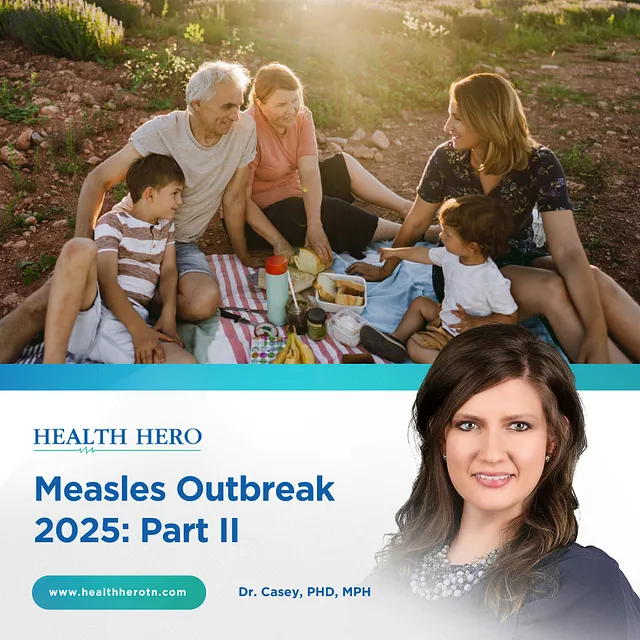As promised, here is the second half of my two-part post on the current measles outbreak in the U.S. As I said in my first post, I wanted to cover two aspects of this incredibly important issue. In the first post, I discussed measles, how vaccines changed the game for this highly contagious disease, and how this put the U.S. on the path to declaring measles eliminated in the nation in 2000. However, as sometimes happens, the drastically lowered risk of measles throughout the last decades has brought a somewhat clouded sense of security for many. The feeling that measles poses no threat has made some, perhaps many, less likely to take the preventive action (i.e., measles vaccination) that achieved the disease’s elimination status.
My point last time was that we must remember how we reached minimal threats of measles and so many other diseases. And we must continue these efforts to sustain the progress made and provide the same safety for future generations. As I said before, and stand by, no child or adult should ever die from a vaccine-preventable illness. This is especially true in a country with resources and medical achievements that are as remarkable as ours. Tragically, though, we have seen otherwise in recent weeks, which is what this post will focus on: the current state of the measles outbreaks in the U.S.
Measles in the U.S. in 2025 by the Numbers
As of March 14, 2025, the Centers for Disease Control and Prevention (CDC) reported a total of 301 confirmed measles cases in the following locations: Alaska, California, Florida, Georgia, Kentucky, Maryland, New Jersey, New Mexico, New York City, New York State, Pennsylvania, Rhode Island, Texas, Vermont, and Washington. There have been many other likely measles cases that have been reported, as well, but the ones counted at this time are the only ones that have been confirmed by CDC. For comparison, there were 285 cases of measles in the entire year of 2024. We are only in March, and we have already surpassed that.
I will link to the CDC’s full page of statistics and data on the measles cases and outbreaks below (which updates each Friday), but I want to highlight some of that information here. In 2025 (although we are only in mid-March), there have been 3 measles outbreaks reported. The CDC defines an outbreak as three or more related cases. Of the 301 confirmed cases, 280 (93%) have been associated with an outbreak. Measles is the most contagious disease transmitted directly between people and one of the most highly contagious infectious diseases known to science. If just one person has measles, up to 9 out of 10 people nearby will become infected if they are unvaccinated. It is far more contagious than influenza or COVID, which is one of the reasons that vaccination against measles is so essential. Without protection, we are extremely vulnerable to measles.
Think of it this way: until now, the odds of being exposed to a measles outbreak have been low, since the disease was eliminated in the U.S. in 2000. However, if someone does happen to be exposed to the virus and is not vaccinated, they are around 90% likely to be infected.
I don’t want to roll those dice. It is important to remember that measles is spread through the air, even by breathing, and infectious droplets can remain in the air or stay on surfaces for two hours. An infected person might be long gone when you touch the same checkout counter they used an hour before you; we have no way of knowing.
So, I will repeat my broken record warning here. Since we never know what germs might “come to us,” so to speak, despite doing our best to stay away from risk, we have to do everything possible to protect ourselves. Making it even more complicated, in the first 2–4 days an individual has measles, symptoms are often common ones such as cough, congestion, and fever. So, it’s not unusual for individuals with measles to think they have just a simple cold at first, and to go about their lives, exposing others while they are highly contagious. To give you an idea of who has been most affected by the current outbreaks, 34% of cases have been under 5 years old, and 42% have been between 5–19 years old. So, children and adolescents make up over two-thirds of current measles cases. In 2025 measles cases, 95% were unvaccinated or had unknown vaccination status. These statistics relate to recent trends in the U.S., indicating lower vaccination rates among children.
I am including links to articles that discuss these trends in the “Want to Learn More?” section below. Of critical importance is that we are now beyond people “just” (I use that term somewhat sarcastically) getting sick from measles. An unvaccinated six-year-old child died from measles in Gaines County, Texas, in February. Measles is also the suspected cause of death of an unvaccinated adult in New Mexico (awaiting confirmation by CDC). This is now, without exaggeration, a deadly outbreak. The concern is that health officials and experts have not seen signs of the outbreak(s) slowing down. How far the outbreak could spread and how many people could be affected is difficult to predict (and I don’t like uncertainty).
One key variable is where or among whom measles tries to spread. If a population has a high vaccination rate (for example, 95%), an outbreak is very unlikely to occur because it does not have much opportunity to spread. However, there isn’t a lot of hard, accurate data that can tell you vaccination percentage rates for different, especially small, areas. We have to think of the worst-case scenario here, and for measles to spread at this time, it is possible that we could see several thousand cases this year. Only time will tell.
Other Thoughts
Again, getting vaccinated is the best personal protection from measles and the most effective way to keep these outbreaks from spreading. There is a lot of detailed information about the measles vaccine (usually combined with mumps and rubella), the age schedule for vaccination, and the number of doses needed. And, of course, there are exceptions to every rule and “what-ifs” to consider, and plenty of other information regarding immunization. Since this is not a highly technical, clinical post about the ins and outs of that extensive information, I am including a link below to the CDC’s very detailed explanation of that. I encourage you to visit the site and see if, even as an adult, you might benefit from a measles booster vaccine. There are also additional links that can answer other questions about why the vaccine is important, facts about safety and effectiveness, possible side effects, and even how to find where it is offered and assistance with paying for it.
Going forward, I hope you will keep aware of the measles outbreak in the U.S. I will include brief updates in upcoming posts or at least mention when/if something noteworthy happens (hopefully, nothing will). If there seems to be interest, I can also write up a quick post on some of the various “remedies” and suggested home prevention methods you may have seen or read about on the news or social media. There is a lot of clarification needed there.
Some of it stems from some accurate information, but much of it has gotten skewed and/or misconstrued. Many health experts, including my colleagues (and myself), are deeply concerned that as these recommendations continue to lose accuracy, individuals will rely on these, thinking they are as effective as vaccination. So, if you are interested in a “debunking”, please let me know! I hope
this post was informative and not too heavy on data and statistics. I look forward to sharing with you again soon.
Be Well; Be Kind,
Dr. Casey
Want to Learn More?
If you want to keep up with the latest numbers of measles cases, outbreaks, and related information, you can check the CDC’s website here (which is updated every Friday): https://www.cdc.gov/measles/data-research/index.html
Just as another reminder of measles symptoms and possible complications, and things to be aware of, here is some detailed information on what to look for, provided by CDC: https://www.cdc.gov/measles/signs-symptoms/index.html
This is another scientific article, so I will repeat my warning that it may be technical in places, but this publication discusses decreasing vaccination rates among children 24 months old and younger looking at data from 2020–2023. It is an interesting read by authors Hill et al.: https://www.cdc.gov/mmwr/volumes/73/wr/mm7338a3.htm
Here is the detailed information I referenced above about the measles vaccine, recommendations, safety, effectiveness, concerns, how to find a vaccine, and even assistance paying for it if needed (and much more) from the CDC:
https://www.cdc.gov/measles/vaccines/index.html?CDC_AA_refVal=https%3A%2F%2F
www.cdc.gov%2Fvaccines%2Fvpd%2Fmmr%2Fpublic%2Findex.html
In case you do not realize the full extent of possible outcomes of measles — both immediate and long-term (which many do not realize), here is a very impactful article on a physician who had just such an experience with one of his patients from NPR:
https://www.npr.org/sections/shots-health-news/2025/03/17/nx-s1-5328765/measles-Outbreak-health-risk


